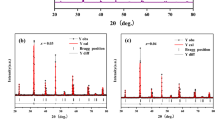Abstract
Doped V2O3 is examined to understand its useful properties as a positive temperature coefficient (PTC) material. The effects of different dopant species and combinations of dopant species and the effects of microstructure are examined in terms of the properties of transition temperature, transition width, resistivity ratio, and transition hysteresis size. In addition to the previously used dopants of Cr and Al, the dopants In, Al+Cr, Al+In, and Al+Ga are also found to be effective at producing a PTC phase transition. The combination of Al+In produced the best resistivity ratio for its transition temperature. Higher sintering temperatures are found to produce larger grains and a sharper transition. The sharper transition is interpreted as the combined effect of heterogeneous nucleation and self-catalysation within a single grain. The hysteresis decreases from over 100 K between the first cooling and the following heating to around 50 K for subsequent thermal cycles. This is most likely a result of the formation of microcracks which are observed in the ceramic. An additional five cycles, though, shows no measurable decrease in the hysteresis size indicating no further growth of the microcracks.
Similar content being viewed by others
References
J. M. HONIG and L. L. VANZANDT,A. Rev. Mater. Sci. 5 (1975) 225
D. B. MCWHAN and J. P. REMEIKA,Phys. Rev. B 2 (1970) 3734.
D. B. MCWHAN, A. MENTH, J. P. REMEIKA, W. F. BRINKMAN and T. M. RICE, ibid.5 (1973) 1920.
M. NOGUCHI, N. KIMIZUKA, T. CHIBA and N. TSUDA,J. Phys. Soc. Jpn 34 (1973) 661.
H. KUWAMOTO, J. M. HONIG and J. APPEL,Phys. Rev. B 22 (1980) 2626.
A. JAYARAMAN, D. B. MCWHAN, J. P. REMEIKA and P. D. DERNIER, ibid.2 (1970) 3751.
S. A. CARTER, J. YANG, T. F. ROSENBAUM, J. SPALEK and J. M. HONIG, ibid.43 (1991) 607.
Author information
Authors and Affiliations
Rights and permissions
About this article
Cite this article
Hendrix, B.C., Wang, X., Chen, W. et al. Understanding doped V2O3 as a functional positive temperature coefficient material. J Mater Sci: Mater Electron 3, 113–119 (1992). https://doi.org/10.1007/BF00695726
Received:
Accepted:
Issue Date:
DOI: https://doi.org/10.1007/BF00695726




